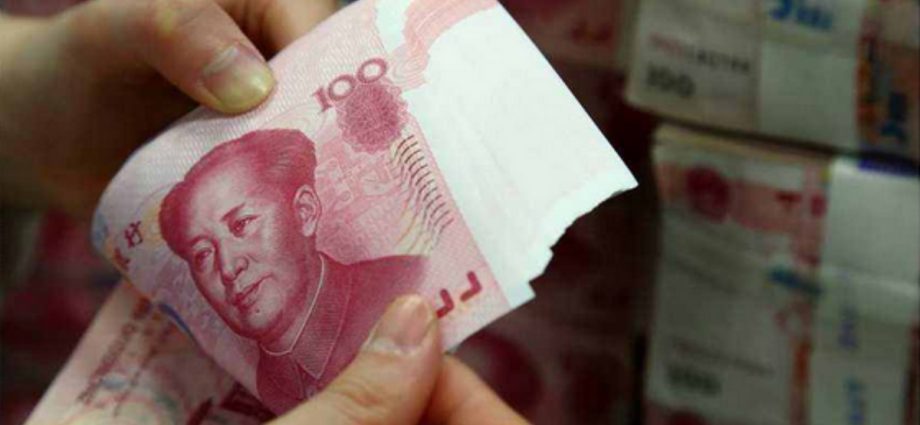
Although China and Russia have in recent months encouraged companies to settle their trade in the two countries’ currencies to try to end “dollar hegemony,” Moscow has so far avoided keeping the yuan because they are a drag on the market.
In a recently-published research report the Bank of Russia, the country’s central bank, explains that Russian exporters and importers suffer from currency risks when settling their trade in the non-convertible and volatile renminbi. It also says there are not enough derivatives for traders to hedge the Chinese currency.
The central bank says Russia has been selling renminbi since the beginning of this year. For example, news media reported, the country on April 10 disposed of about 320 million yuan ($46.6 million) in exchange for Western currencies.
On April 5, reporters asked Dmitry Tulin, the first deputy governor of the Bank of Russia, why Russia had dumped yuan in February and March. He blamed Beijing for refusing to allow Russian companies and individuals to hold renminbi in cash.
“Although renminbi has become a leading transaction currency on the Moscow Exchange and China is now Russia’s biggest trading partner, the Chinese central bank does not want renminbi notes to be circulated overseas,” Tulin said.
He said Russia had held high hopes of being able to get yuan notes as a substitute of the dollars and euros but such hopes vanished.
He said because of this, there is no room for the Russian central bank to ease the existing rule under which an individual in Russia can withdraw no more than US$10,000 worth of foreign currencies from bank accounts annually. He said the rule has been extended to September 9.
China has promoted renminbi internationalization for more than a decade but, probably for anti-money laundering reasons, allows the use of its money notes only within its territories including Hong Kong and Macau.
Tulin’s speech is cited by a Chinese writer called Xu Sanlang in an article published on April 10.
Xu says that, because Russia has decided to allow foreigners to sell their Russian assets worth up to $15-20 billion within 2023, it will face a capital outflow of that amount this year. He says the ruble will be under pressure as Russia cannot be paid in US dollars and euros due to the West’s sanctions.
He says that, since Beijing and Moscow started promoting the use of local currencies in trade settlement last year, Russia has accumulated about 251.5 billion yuan ($36.5 billion).
He notes that the Russian National Wealth Fund, a sovereign fund, has vowed to convert 60% of its foreign reserves into renminbi within the next few years but, in reality, it keeps selling renminbi assets. He says Russia held under 20 billion yuan of renminbi assets at the end of March.
Between last July and November, the ruble was floating at 60 to the US dollar. But since December, it has gradually declined by 27%. It was trading at 81.9 to the dollar on Wednesday. News media report that Russians have been queuing up in banks for foreign currencies in recent months.
On March 21, Chinese President Xi Jinping and Russian President Vladimir Putin met in Moscow and agreed to strengthen the economic tie between China and Russia.
But on April 11, the Bank of Russia published its research report, titled “Overview of the Russian Financial Sector and Financial Tools,” to point out the problems of yuan-ruble trade settlement.
The report says that due to the West’s sanctions, Russia now receives more “currencies of friendly countries” but the country’s exporters and importers face new currency risks as their trading contracts are still denominated in US dollars and euros.
“The currencies of friendly countries are usually non-convertible or partially convertible,” it says. “They may have a high volatility but there are less derivatives for these currencies than the traditional ones, which makes it difficult for traders to hedge their currencies.”
It says it is complicated for two “friendly countries” to settle trade in local currencies if they have an imbalanced bilateral trade. It says one side may either have insufficient or too much of the other side’s currency.
“When we pay for goods of ‘friendly countries’ in their currencies, some countries require us to pay in dollars and euros. This creates additional difficulties to us,” it says.
It says Russia will still have to obtain enough “currencies of unfriendly states,” a term that refers to dollars and euros, to buy foreign goods. It adds that selling renminbi for these currencies will increase Russia’s cost of imports while the involved Chinese banks may face secondary sanctions.
The report was first cited by Chinese media on April 12, followed by more news websites over the past few days. Some Chinese columnists tried to defend the Sino-Russia currency partnership.
On Tuesday, a Chongqing-based writer published an article with the title “Russia turned hostile. What’s its intention to dump renminbi? Will the Sino-Russia relations be affected?”
He says Russia seems ruthless in selling yuan but such a move can be justified as the country is being sanctioned by the US and Europe while the renminbi has depreciated since last year. He says by selling the Chinese currency, Russia has also contributed to renminbi internationalization.
Over the past one year, the renminbi has eased about 7.3% to 6.89 to one dollar. Last November, it fell to as low as 7.3 to one dollar.
Read: China eyes Russia’s Far East resources, ‘patriots’ want more
Follow Jeff Pao on Twitter at @jeffpao3

